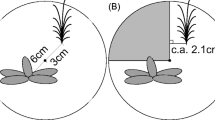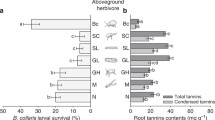Abstract
Growing interest in belowground herbivory and the remarkable diversity of the accumulated information on this topic inspired us to quantitatively explore the variation in the outcomes of individual studies. We conducted a meta-analysis of 85 experimental studies reporting the effects of root-feeding insect herbivores (36 species) on plants (75 species). On average, belowground herbivory led to a 36.3% loss of root biomass, which was accompanied by a reduction in aboveground growth (−16.3%), photosynthesis (−11.7%) and reproduction (−15.5%). The effects of root herbivory on aboveground plant characteristics were significant in agricultural and biological control studies, but not in studies of natural systems. Experiments conducted in controlled environments yielded larger effects on plants than field experiments, and infestation experiments resulted in more severe effects than removal studies employing natural levels of herbivory. Simulated root herbivory led to greater aboveground growth reductions than similar root loss imposed by insect feeding. External root chewers caused stronger detrimental effects than sap feeders or root borers; specialist herbivores imposed milder adverse effects on plants than generalists. Woody plants suffered from root herbivory more than herbaceous plants, although root loss was similar in these two groups. Evergreen woody plants responded to root herbivory more strongly than deciduous woody plants, and grasses suffered from root herbivory more than herbs. Environmental factors such as drought, poor nutrient supply, among-plant competition, and aboveground herbivory increased the adverse effects of root damage on plants in an additive manner. In general, plant tolerance to root herbivores is lower than tolerance to defoliating aboveground herbivores.





Similar content being viewed by others
References
Agrawal AA (2004) Resistance and susceptibility of milkweed: competition, root herbivory, and plant genetic variation. Ecology 85:2118–2133
Andersen DC (1987) Belowground herbivory in natural communities—a review emphasizing fossorial animals. Q Rev Biol 62:261–286
Barton KE, Koricheva J (2010) The ontogeny of plant defense and herbivory: characterizing general patterns using meta-analysis. Am Nat 175:481–493
Bazzaz FA, Chiariello NR, Coley PD, Pitelka LF (1987) Allocating resources to reproduction and defense. Bioscience 37:58–67
Bigger D, Marvier MA (1998) How different would a world without herbivory be? A search for generality in ecology. Integr Biol Issues News Rev 1:60–67
Blossey B, Hunt-Joshi TR (2003) Belowground herbivory by insects: influence on plants and aboveground herbivores. Ann Rev Entomol 48:521–547
Brown VK, Gange AC (1989) Differential effects of above-ground and below-ground insect herbivory during early plant succession. Oikos 54:67–76
Brown VK, Gange AC (1990) Insect herbivory below ground. Adv Ecol Res 20:1–58
Chapin FS, Schulze ED, Mooney HA (1990) The ecology and economics of storage in plants. Ann Rev Ecol Syst 21:423–447
Eissenstat DM, Yanai RD (1997) The ecology of root lifespan. Adv Ecol Res 27:1–60
Gange AC, Brown VK (1989) Effects of root herbivory by an insect on a foliar feeding species, mediated through changes in the host plant. Oecologia 81:38–42
Gange AC, Brown VK, Farmer LM (1991) Mechanisms of seedling mortality by subterranean insect herbivores. Oecologia 88:228–232
Gurevitch J, Hedges LV (2001) Meta-analysis. Combining the results of independent experiments. In: Schneider SM, Gurevitch J (eds) Design and analysis of ecological experiments. Oxford University Press, Oxford, pp 347–369
Haukioja E, Koricheva J (2000) Tolerance to herbivory in woody vs. herbaceous plants. Evol Ecol 14:551–562
Hawkes CV, Sullivan JJ (2001) The impact of herbivory on plants in different resource conditions: a meta-analysis. Ecology 82:2045–2058
Houle G, Simard G (1996) Additive effects of genotype, nutrient availability and type of tissue damage on the compensatory response of Salix planifolia ssp. planifolia to simulated herbivory. Oecologia 107:373–378
Hunter MD (2001) Out of sight, out of mind: the impacts of root-feeding insects in natural and managed systems. Agric For Entomol 3:3–9
Hunter MD (2008) Root herbivory in forest ecosystems. In: Johnson SN, Murray PJ (eds) Root feeders: an ecosystem perspective. CABI, Wallingford, pp 68–95
Ingham RE, Detling JK (1986) Effects of defoliation and nematode consumption on growth and leaf gas exchange in Bouteloua curtipendula. Oikos 46:23–28
Johnson SN, Hawes C, Karley AJ (2009) Reappraising the role of plant nutrients as mediators of interactions between root- and foliar-feeding insects. Funct Ecol 23:699–706
Kaplan I, Halitschke R, Kessler A, Sardanelli S, Denno RF (2008) Constitutive and induced defenses to herbivory in above- and belowground plant tissues. Ecology 89:392–406
Karban R, Brody AK, Schnathorst WC (1989) Crowding and a plant ability to defend itself against herbivores and diseases. Am Nat 134:749–760
Koo AJK, Howe GA (2009) The wound hormone jasmonate. Phytochemistry 70:1571–1580
Kozlov MV, Zvereva EL, Zverev VE (2009) Impacts of point polluters on terrestrial biota: comparative analysis of 18 contaminated areas. Springer, Dordrecht
Ladd TL, Buriff CR (1979) Japanese beetle (Coleoptera: Scarabaeidae): influence of larval feeding on bluegrass yields at two levels of soil moisture. J Econ Entomol 72:311–314
Malecki RA, Blossey B, Hight SD, Schroeder D, Kok LT, Coulson JR (1993) Biological control of purple loosestrife. Bioscience 43:680–686
Maron JL (1998) Insect herbivory above- and belowground: individual and joint effects on plant fitness. Ecology 79:1281–1293
Maron JL (2001) Intraspecific competition and subterranean herbivory: individual and interactive effects on bush lupine. Oikos 92:178–186
Maschinski J, Whitham TG (1989) The continuum of plant responses to herbivory—the influence of plant association, nutrient availability, and timing. Am Nat 134:1–19
Masters GJ, Brown VK, Gange AC (1993) Plant mediated interactions between aboveground and belowground insect herbivores. Oikos 66:148–151
McEvoy P, Cox C, Coombs E (1991) Successful biological control of ragwort, Senecio jacobaea, by introduced insects in Oregon. Ecol Appl 1:430–442
Møller AP, Jennions MD (2001) Testing and adjusting for publication bias. Trends Ecol Evol 16:580–586
Morón-Ríos A, Dirzo R, Jaramillo VJ (1997) Defoliation and below-ground herbivory in the grass Muhlenbergia quadridentata: effects on plant performance and on the root-feeder Phyllophaga sp. (Coleoptera, Melolonthidae). Oecologia 110:237–242
Morris WF, Hufbauer RA, Agrawal AA, Bever JD, Borowicz VA, Gilbert GS, Maron JL, Mitchell CE, Parker IM, Power AG, Torchin ME, Vazquez DP (2007) Direct and interactive effects of enemies and mutualists on plant performance: a meta-analysis. Ecology 88:1021–1029
Nykänen H, Koricheva J (2004) Damage-induced changes in woody plants and their effects on insect herbivore performance: a meta-analysis. Oikos 104:247–268
Paillet Y, Berges L, Hjalten J, Odor P, Avon C, Bernhardt-Romermann M, Bijlsma RJ, De Bruyn L, Fuhr M, Grandin U, Kanka R, Lundin L, Luque S, Magura T, Matesanz S, Meszaros I, Sebastia MT, Schmidt W, Standovar T, Tothmeresz B, Uotila A, Valladares F, Vellak K, Virtanen R (2010) Biodiversity differences between managed and unmanaged forests: meta-analysis of species richness in Europe. Conserv Biol 24:101–112
Poveda K, Jimenez MIG, Kessler A (2010) The enemy as ally: herbivore-induced increase in crop yield. Ecol Appl 20:1787–1793
Riedell WE, Reese RN (1999) Maize morphology and shoot CO2 assimilation after root damage by western corn rootworm larvae. Crop Sci 39:1332–1340
Rosenberg MS, Adams DC, Gurevitch J (2000) MetaWin: statistical software for meta-analysis. Version 2.0. Sinauer, Sunderland
Saner MA, Müller-Schärer H (1994) Impact of root mining by Eteobalea spp. on clonal growth and sexual reproduction of common toadflax, Linaria vulgaris Mill. Weed Res 34:199–204
SAS Institute (2009) SAS/STAT user’s guide, version 9.2. SAS Institute, Cary
Seastedt TR, Ramundo RA, Hayes DC (1988) Maximization of densities of soil animals by foliage herbivory—empirical evidence, graphical and conceptual models. Oikos 51:243–248
Stein C, Unsicker SB, Kahmen A, Wagner M, Audorff V, Auge H, Prati D, Weisser WW (2010) Impact of invertebrate herbivory in grasslands depends on plant species diversity. Ecology 91:1639–1650
Strauss SY, Agrawal AA (1999) The ecology and evolution of plant tolerance to herbivory. Trends Ecol Evol 14:179–185
Tilman D (1989) Competition, nutrient reduction and the competitive neighborhood of a bunchgrass. Funct Ecol 3:215–219
van Dam NM (2009) Belowground herbivory and plant defenses. Ann Rev Ecol Evol Syst 40:373–391
van Dam NM, Heil M (2011) Multitrophic interactions below and above ground: en route to the next level. J Ecol 99:77–88
van der Putten WH (2003) Plant defense belowground and spatiotemporal processes in natural vegetation. Ecology 84:2269–2280
Wise MJ, Abrahamson WG (2005) Beyond the compensatory continuum: environmental resource levels and plant tolerance of herbivory. Oikos 109:417–428
Wolf A, Kozlov MV, Callaghan TV (2008) Impact of non-outbreak insect damage on vegetation in northern Europe will be greater than expected during a changing climate. Clim Change 87:91–106
Wurst S, van der Putten WH (2007) Root herbivore identity matters in plant-mediated interactions between root and shoot herbivores. Basic Appl Ecol 8:491–499
Zvereva EL, Kozlov MV (2006) Consequences of simultaneous elevation of carbon dioxide and temperature for plant–herbivore interactions: a metaanalysis. Global Change Biol 12:27–41
Zvereva EL, Kozlov MV (2010) Responses of terrestrial arthropods to air pollution: a meta-analysis. Environ Sci Pollut R 17:297–311
Zvereva EL, Lanta V, Kozlov MV (2010) Effects of sap-feeding insect herbivores on growth and reproduction of woody plants: a meta-analysis of experimental studies. Oecologia 163:949–960
Acknowledgments
We are grateful to Dr. W. Riedell for providing additional information, to A. Stekolshchikov for assistance in publication searches, and to two anonymous reviewers for valuable comments on an earlier version of the manuscript. The study was supported by the Academy of Finland (project number 122133) and a Turku University strategic research grant.
Author information
Authors and Affiliations
Corresponding author
Additional information
Communicated by Stefan Scheu.
Electronic supplementary material
Below is the link to the electronic supplementary material.
Rights and permissions
About this article
Cite this article
Zvereva, E.L., Kozlov, M.V. Sources of variation in plant responses to belowground insect herbivory: a meta-analysis. Oecologia 169, 441–452 (2012). https://doi.org/10.1007/s00442-011-2210-y
Received:
Accepted:
Published:
Issue Date:
DOI: https://doi.org/10.1007/s00442-011-2210-y




